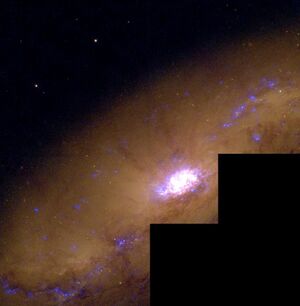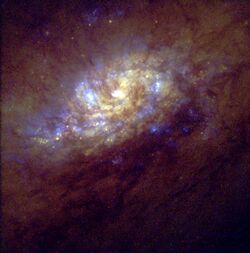Astronomy:NGC 1808
| NGC 1808 | |
|---|---|
 | |
| Observation data (J2000 epoch) | |
| Constellation | Columba[2] |
| Right ascension | 05h 07m 42.343s[3] |
| Declination | −37° 30′ 46.98″[3] |
| Redshift | 995[4] |
| Distance | 41.7 ± 3.9 Mly (12.8 ± 1.2 Mpc)[5] |
| Group or cluster | Dorado Group |
| Apparent magnitude (V) | 9.94[6] |
| Apparent magnitude (B) | 10.83[4] |
| Absolute magnitude (B) | −20.17[7] |
| Characteristics | |
| Type | (R)SAB(s)a[7] |
| Apparent size (V) | 7′.41 × 3′.39[8] |
| Other designations | |
| PGC 16779[9] | |
NGC 1808 is a barred spiral galaxy[5] located in the southern constellation of Columba, about two degrees to the south and east of Gamma Caeli.[2] It was discovered by Scottish astronomer James Dunlop, who described it as a "faint nebula".[10] The galaxy is a member of the NGC 1808 group, which is part of the larger Dorado Group.[10]
The morphological classification of this galaxy is (R)SAB(s)a,[7] which indicates a spiral galaxy with a weak-bar around the nucleus (SAB), no ring around the bar (s), an outer ring (R), and tightly-wound spiral arms (a). It is inclined by an angle of 57° to the line of sight from the Earth, with the long axis oriented at a position angle of 324°.[5] The disk of gas and stars shows a noticeable warp, and there is a pronounced asymmetry in the distribution of neutral hydrogen and H II regions.[11]
The core region contains a suspected weak active galactic nucleus plus a circumnuclear ring containing star clusters and supernova remnants at a distance of ~280 pc from the center. These form a ring of peculiar "hot spots".[12] It was formerly identified as a possible Seyfert galaxy,[5] but evidence now points to starburst activity in a ~500 pc radius around the center.[13] A probable outflow of gas is directed to the north-east from the nucleus, forming prominent dust lanes.[5] The high level of star formation in this galaxy and the nearby NGC 1792 may indicate a recent, distant tidal interaction between the two.[11]
The type Ia supernova SN 1993af was discovered in November 1993 at 220″ east and 94″ north of the galactic nucleus.[14][15]
References
- ↑ "HubbleSite - NewsCenter - Hubble Captures the Heart of Star Birth". http://hubblesite.org/newscenter/archive/releases/1998/12/fastfacts/.
- ↑ 2.0 2.1 Sinnott, Roger W.; Perryman, Michael A. C. (1997). Millennium Star Atlas. 1. Sky Publishing Corporation and the European Space Agency. ISBN 0-933346-84-0.
- ↑ 3.0 3.1 Skrutskie, Michael F. et al. (1 February 2006). "The Two Micron All Sky Survey (2MASS)". The Astronomical Journal 131 (2): 1163–1183. doi:10.1086/498708. ISSN 0004-6256. Bibcode: 2006AJ....131.1163S.
- ↑ 4.0 4.1 Tully, R. Brent et al. (August 2016). "Cosmicflows-3". The Astronomical Journal 152 (2): 21. doi:10.3847/0004-6256/152/2/50. 50. Bibcode: 2016AJ....152...50T.
- ↑ 5.0 5.1 5.2 5.3 5.4 Busch, Gerold et al. (February 2017). "Star formation and gas flows in the centre of the NUGA galaxy NGC 1808 observed with SINFONI". Astronomy & Astrophysics 598: 19. doi:10.1051/0004-6361/201629440. A55. Bibcode: 2017A&A...598A..55B.
- ↑ Armando, Gil de Paz et al. (2007). "The GALEX Ultraviolet Atlas of Nearby Galaxies". Astrophysical Journal 173 (2): 185–255. doi:10.1086/516636. Bibcode: 2007ApJS..173..185G.
- ↑ 7.0 7.1 7.2 Erwin, Peter; Debattista, Victor P. (June 2013). "Peanuts at an angle: detecting and measuring the three-dimensional structure of bars in moderately inclined galaxies". Monthly Notices of the Royal Astronomical Society 431 (4): 3060–3086. doi:10.1093/mnras/stt385. Bibcode: 2013MNRAS.431.3060E.
- ↑ Paturel, G. et al. (December 2003). "HYPERLEDA. I. Identification and designation of galaxies". Astronomy and Astrophysics 412: 45–55. doi:10.1051/0004-6361:20031411. Bibcode: 2003A&A...412...45P.
- ↑ "NASA/IPAC Extragalactic Database". Results for NGC 1808. http://nedwww.ipac.caltech.edu/.
- ↑ 10.0 10.1 O'Meara, Stephen James (2013), Deep-Sky Companions: Southern Gems, Cambridge University Press, p. 116, ISBN 978-1107015012, Bibcode: 2013dcsg.book.....O, https://books.google.com/books?id=BoIsCgAAQBAJ&pg=PA116
- ↑ 11.0 11.1 Dahlem, M. et al. (July 2001). "A search for intergalactic H I gas in the NGC 1808 group of galaxies". Astronomy and Astrophysics 373 (2): 485–493. doi:10.1051/0004-6361:20010614. Bibcode: 2001A&A...373..485D.
- ↑ Salak, Dragan et al. (May 2016). "Gas Dynamics and Outflow in the Barred Starburst Galaxy NGC 1808 Revealed with ALMA". The Astrophysical Journal 823 (1): 28. doi:10.3847/0004-637X/823/1/68. 68. Bibcode: 2016ApJ...823...68S.
- ↑ Salak, Dragan et al. (November 2017). "Evolution of Molecular Clouds in the Superwind Galaxy NGC 1808 Probed by ALMA Observations". The Astrophysical Journal 849 (2): 20. doi:10.3847/1538-4357/aa91cb. 90. Bibcode: 2017ApJ...849...90S.
- ↑ Hamuy, M. et al. (November 1993). Green, D. W. E.. ed. "Supernovae 1993af, 1993ag, 1993ah". IAU Circular 5895: 1. Bibcode: 1993IAUC.5895....1H.
- ↑ Hamuy, M. et al. (December 1996). "BVRI Light Curves for 29 Type IA Supernovae". Astronomical Journal 112: 2408. doi:10.1086/118192. Bibcode: 1996AJ....112.2408H.
External links
 |


